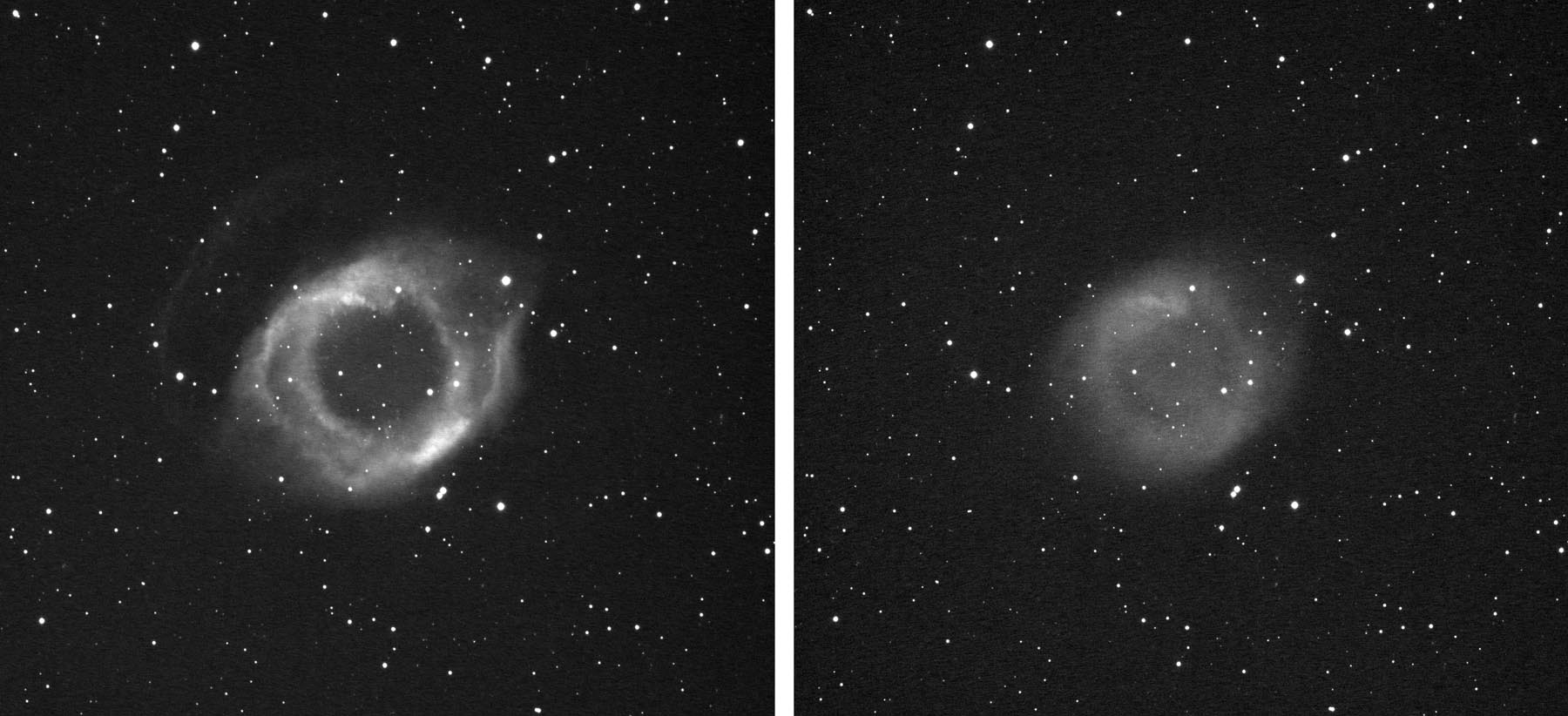
 | SOCO Blog |
16 October 2015
HELIX AND DUMBBELL NEBULAS
At last, some clear skies! The past week has produced four nights with beautiful clear, moonless skies, allowing me to image a total of seven objects. My sleep has certainly suffered by staying up 'til 4:00 am, but it has been worth it. It probably won't be too long before the passing cold fronts bring those 3-C nights (clear, calm, cold), but for now I'm enjoying the milder night temperatures without the need to bundle up in the big coat and stocking cap. But, it's coming, I know.
One of the objects I images is NGC 7293, commonly called the Helix Nebula. This is a big, relatively bright planetary nebula in the constellation Aquarius. I had imaged it several years ago, but figured it was time to image it again with the new SOCO imaging system, including the new focuser and filter set. Sue French devotes a whole chapter to the Helix in her book Celestial Sampler (Sky Publishing, Cambridge, MA, 2005). As she describes, it is one of the closest planetary nebulas, lying at a distance of around 300 LY. It covers an area of the sky of around 16 × 12 arc-min (about half the diameter of the moon). This is huge for planetary nebulas, as most of them (and there are quite a few) appear pretty much stellar to observers with relatively small telescopes. The Helix shows up clearly on Plate 68 of the Cambridge Photographic Star Atlas (Axel Mellinger and Ronald Stoyan, Cambridge University Press, 2011). The Helix Nebula was discovered by Charles Ludwig Harding, probably before 1824.
My image of the Helix is shown in Figure 1. It was created from twenty 3-minute images acquired in each of the red, green and blue spectral bands.

Figure 1. NGC 7293, the Helix Nebula in Aquarius.
Planetary nebulas like the Helix are formed when a star similar in size to our sun uses up most of the hydrogen in its core. Gravity causes the core to contract and heat up, with this heat causing the star's outer layers to expand, forming a red giant star. At the end of this phase, the outer stellar atmosphere is blown off into an expanding shell around the star. Ultraviolet light from the contracting core of the star ionizes the gases in the shell, producing the visible nebula. The star eventually becomes a white dwarf. The shell continues to expand, and eventually becomes so thin and distant from the central star that it fades from view. The Helix Nebula is relatively young, with an estimated age of around 10,600 years.
The name "Helix" comes from the appearance of the nebula, where the outer regions appear to form a helical coil oriented in the general direction of the viewer. The coil appears to make almost two complete turns. This shape is most easily seen in the red spectral band. Figure 2 shows red and green images of the nebula (the blue image is similar in appearance to the green image). The actual physical shape of the nebula is an ellipsoid oriented along the direction of the "coils". Planetary nebulas come in a variety of shapes, each dictated by the particular expansion characteristics of the nebular shell following its ejection from the central star. A feature of many planetary nebulas is that the central star is still rather easily visible. The central star in the Helix shines at a magnitude of 13.5.

Figure 2. The Helix Nebula, (left) red spectral band, (right) green spectral band.
Another feature of the Helix Nebula is a barely visible outer arc of glowing gas. In Figure 1, it can just be seen above the sky background to the upper left of the main nebula. It is more easily visible in the red spectral band. Figure 3 shows an enhanced version of the red image of the nebula, in which this outer arc is more easily seen. This arc of gas is thought to be from an expansion of the central star's outer atmosphere prior to the one resulting in the main body of the nebula.

Figure 3. Enhanced red image of the Helix Nebula showing the outer arc.
Another beautiful planetary nebula that is visible this time of year is M 27 (NGC 6853), the Dumbbell Nebula in the constellation Vulpecula. My image of it is shown in Figure 4, acquired on a rare clear night about a month ago on September 16. M 27 is smaller (around 8 arc-min in diameter) than the Helix, but has a similar overall brightness (magnitude 7.4). It is located at around 1150 LY from us, within the sweep of the Milky Way. It was discovered by Charles Messier in July of 1764. It has the distinction of being the first planetary nebula discovered. However, Messier was unaware of its true nature and described it simply as a "nebula without star". He obviously could not detect the central star in his telescope.

Figure 4. M 27 (NGC 6853), the Dumbbell Nebula in Vulpecula.
The name of the nebula, the Dumbbell, is attributed to the English astronomer John Herschel, who called it "a nebula shaped like a dumbbell". In a later description, he stated it was "shaped something like an hourglass" but his original description has stuck. This planetary nebula has an ellipsoidal structure like the Helix Nebula, except in the case of M 27 this structure is oriented more perpendicular to our line of sight. Also similar to the Helix, the central star in M 27 has a visual magnitude of 13.5. The reddish components of the nebula, which help give it the "hourglass" or "dumbbell" shape, represent strong Hα emissions. The greenish-blue glow from OIII and Hβ emissions are more diffuse and uniform over the extent of the nebula. As with the Helix Nebula, there is a faint outer shell to M 27, but I have not detected it in my imagery.
This is a good start to the Fall observing season. I hope to be able to present the results of many more observations over the next few weeks. I'm keeping my fingers crossed and hoping for continued clear skies!
 Return to SOCO Blog Page
Return to SOCO Blog Page
 Return to SOCO Main Page
Return to SOCO Main Page
Questions or comments? Email SOCO@cat-star.org